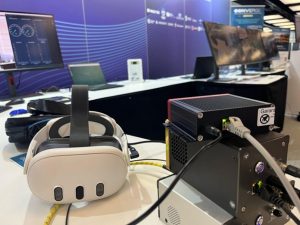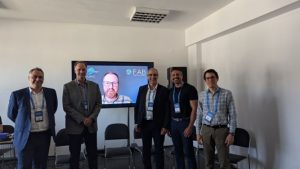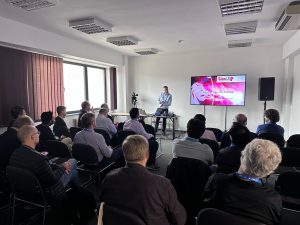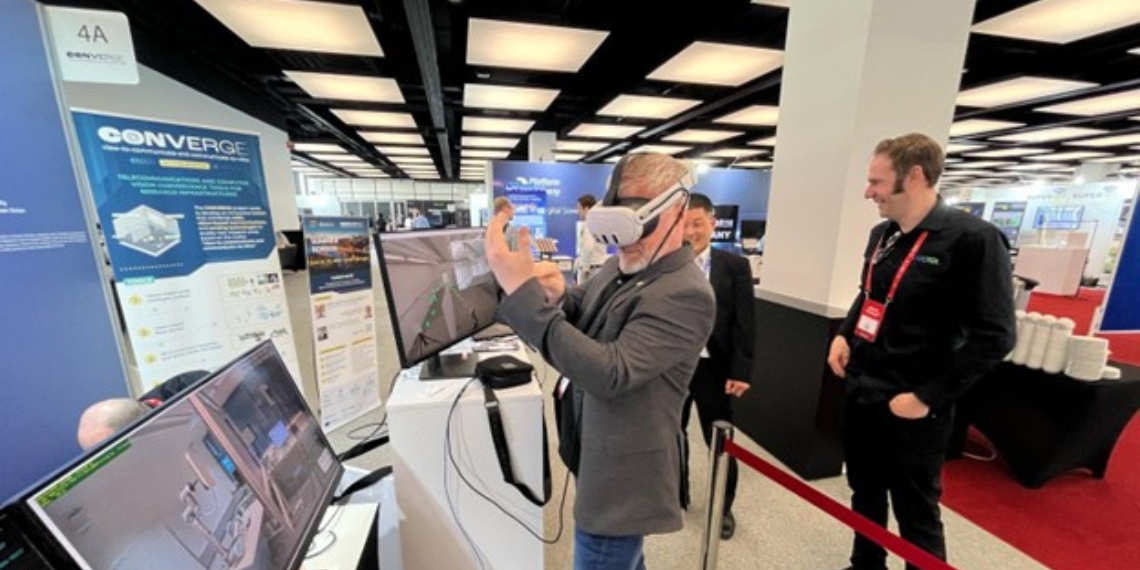INESC TEC took central stage at one of the largest meetings of 5G, IoT, and 6G experts. At the EuCNC & 6G Summit 2025, held in Poznan (Poland), the Institute made the invisible visible through a demonstration using mixed reality.
But let’s take it one step at a time. What is mixed reality? It is the combination of Augmented Reality (AR) and Virtual Reality (VR) technologies. And what did INESC TEC manage to demonstrate? Through an innovative mixed reality demonstration, visitors to the EuCNC & 6G Summit 2025 exhibition were able to “observe” 5G and 6G radio signals – which are usually invisible – in the surrounding space.
How did the research team from INESC TEC achieve this? The demonstration was part of the CONVERGE project (coordinated by INESC TEC) and involved real-time digital twins of two laboratories located across Europe: in Porto, Portugal, and in Oulu, Finland. This enabled the creation of a unique interactive experience, where participants could remotely control equipment like robotic arms, radio units, RF signal-blocking curtains (wireless electromagnetic signals used for communication), and reconfigurable intelligent surfaces (RIS) through XR interfaces (flexible platforms for immersive experiences).
“Through AR and VR technologies, participants interacted with 3D replicas of real laboratory environments, visualising the behaviour of wireless signals, key network performance indicators (KPIs), and even key value items (KVIs) – all presented through gamified and intuitive interfaces,” explained Luís Pessoa, a researcher at INESC TEC and coordinator of the CONVERGE European project.
The goal of the demonstration was to show how the convergence of XR, digital twins, and advanced communications can transform the way we interact with technical infrastructures and network environments – particularly in industrial, research, and remote-control scenarios.
The demonstration was the result of a collaboration between the CONVERGE project (funded by the Horizon Europe programme) and Finland’s 6G Flagship, with the support of the 6G-Sandbox project. Together, the three stands at the event showcased different aspects of the same vision: smart infrastructures (6G Flagship), immersive experimental applications (CONVERGE), and continental digital twins with location navigation (6G-Sandbox).
“With this joint presence, we were able to demonstrate the potential for real-time cross-border interaction with laboratory environments, using immersive technologies to facilitate experimentation, monitoring, and remote control of networks and devices,” added INESC TEC researcher Filipe B. Teixeira.
The demonstration is available here.

INESC TEC’s presence translated into more than just demonstrations: two workshops on 6G hardware and transatlantic cooperation were also part of INESC TEC’s contribution to the EuCNC & 6G Summit 2025
In addition to the immersive demonstration of the CONVERGE project, INESC TEC played a prominent role in the scientific organisation of the EuCNC & 6G Summit 2025, co-organising two highly relevant workshops for the future of mobile networks and participating in two others.
“Hardware Components Evolution Towards 6G” was the name of one of the workshops co-organised by INESC TEC, which brought together 10 projects from the European SNS (Smart Networks and Services Joint Undertaking) programme – including TERRAMETA, also coordinated by INESC TEC. The workshop, co-organised by Luís Pessoa, focused on the evolution of critical hardware components for 6G networks, e.g., mmWave/sub-THz integrated circuits, integrated photonics, waveguide antennas, and RF-SOI hybrid integration, highlighting strategic links with the European Chips JU programme, which aims to strengthen Europe’s sovereignty in microelectronics.
The workshop concluded with a panel discussion moderated by Bernard Barani (6G-IA), featuring representatives from the X-TREME 6G project (a “lighthouse” microelectronics project under SNS-JU), PROTEUS6G, and INSTICT/6G-SENSES. “In this panel, the new challenges that the evolution towards 6G imposes on microelectronics capabilities were discussed, including the need for more efficient, integrable, and operable technologies at high frequencies. The priorities of the SNS-JU programme for microelectronics in future European calls were also discussed, as well as the strategic importance of the Chips JU pilot-lines as facilitators of the development and validation of European solutions for key components of future 6G networks,” explained researcher Luís Pessoa.
Luís Pessoa also co-organised the workshop “EU–US Cooperation on Advanced Research Platforms: Driving Innovation Across the Full Research Lifecycle”, which promoted transatlantic dialogue between six research projects from Europe and the United States, including the CONVERGE project.
With participation from entities such as the NSF (National Science Foundation) and SNS JU, this workshop discussed the role of experimental platforms in advancing 6G networks, focusing on topics such as interoperability, open data, scientific reproducibility, and the scalability of testing infrastructures.
“Projects like SLICES-RI, 6G-SANDBOX, and CONVERGE presented practical approaches, highlighting the value of international cooperation to accelerate innovation and ensure that new network paradigms are tested in an open, reliable, and collaborative manner,” explained Luís Pessoa.
The workshop included a panel discussion moderated by Odysseas Pyrovolakis (SNS-JU) with representatives from EU and US research platforms, fostering an active discussion on the future of experimental infrastructures, expected technological evolution, and pathways for effective global collaboration. Topics discussed included the sharing of testbeds between continents, the gaps that remain to ensure technical capabilities suitable for 6G, challenges and barriers in platforms like FABRIC, the definition of long-term performance indicators (KPIs), the role of open-source solutions, and the sharing of open data as a pillar of replicable and scalable research.
“With these two initiatives, INESC TEC reinforced our commitment to scientific and technological leadership in Europe in the field of future communication networks,” explained the researcher.

Participation in other workshops during the EuCNC & 6G Summit 2025
In addition to said initiatives, INESC TEC also participated in two other workshops during the conference.
“6G Experimentation Methodologies, Pitfalls, and Best Practices” was the name of the workshop where INESC TEC was represented by researcher Filipe B. Teixeira. Dedicated to sharing best practices and experimentation methodologies developed by SNS JU projects, with the aim of improving the quality and reliability of experimental results in the context of 6G networks, the INESC TEC researcher presented the work “How to ensure multi-modal data synchronisation and annotation”.
“In this presentation, I shared ongoing work within the CONVERGE project related to the acquisition of multimodal data with high-precision synchronisation, as well as the creation and publication of the corresponding datasets,” explained Filipe B. Teixeira.
Finally, the Institute was represented at the workshop “Integrated Sensing and Communications (ISAC) – European Research Framework”. This workshop brought together over 15 European projects funded by the SNS JU programme to discuss advances and challenges in the integration of communication and sensing capabilities in future 6G networks. Luís Pessoa participated as a speaker in the panel dedicated to research at the physical (PHY) level, where he discussed developments in the TERRAMETA project of sub-THz reconfigurable intelligent surfaces and their importance for ISAC applications. The session addressed topics such as innovations in the physical layer, system-level improvements, real-world implementation experiences, and standardisation efforts, highlighting the importance of European collaboration for the evolution of ISAC technologies in the 6G context.

About the EuCNC & 6G Summit 2025
The EuCNC & 6G Summit combines two successful telecommunications conferences: EuCNC (European Conference on Networks and Communications), supported by the European Commission, and the 6G Summit, which originated from the 6G Flagship programme in Finland.
“The conference is sponsored by the IEEE Communications Society (ComSoc), the European Association for Signal Processing (EURASIP), and the European Association on Antennas and Propagation (EurAAP), and focuses on all aspects of telecommunications, from 5G deployment and mobile IoT to the exploration of 6G and future communication systems and networks, including experimentation and testbeds, as well as applications and services,” as stated on the organisation’s website.
This event is the meeting point of cutting-edge research, renowned industries and companies, bringing together over 40 countries; it features an exhibition with more than 50 exhibitors, aimed at presenting, discussing, and demonstrating the latest technologies and results in these fields.
The researchers mentioned in this news piece are associated with INESC TEC and the Faculty of Engineering of the University of Porto (FEUP).



 News, current topics, curiosities and so much more about INESC TEC and its community!
News, current topics, curiosities and so much more about INESC TEC and its community!